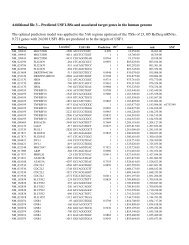Neurofibromatosis type 1-associated tumours ... - Human Genomics
Neurofibromatosis type 1-associated tumours ... - Human Genomics
Neurofibromatosis type 1-associated tumours ... - Human Genomics
Create successful ePaper yourself
Turn your PDF publications into a flip-book with our unique Google optimized e-Paper software.
REVIEW<br />
Laycock-van Spyk et al.<br />
43. Ducatman, B., Scheithauer, B., Piepgras, D., Reiman, H. et al. (1986),<br />
‘Malignant peripheral nerve sheath tumors. A clinicopathologic study of<br />
120 cases’, Cancer Vol. 57, pp. 2006–2021.<br />
44. Evans, D., Baser, M., McGaughran, J., Sharif, S. et al. (2002), ‘Malignant<br />
peripheral nerve sheath <strong>tumours</strong> in neurofibromatosis 1’, J. Med. Genet.<br />
Vol. 39, pp. 311–314.<br />
45. McCaughan, J., Holloway, S., Davidson, R. and Lam, W. (2007),<br />
‘Further evidence of the increased risk for malignant peripheral nerve<br />
sheath tumour from a Scottish cohort of patients with neurofibromatosis<br />
<strong>type</strong> 1’, J. Med. Genet. Vol. 44, pp. 463–466.<br />
46. Spurlock, G., Griffiths, S., Uff, J. and Upadhyaya, M. (2007), ‘Somatic<br />
alterations of the NF1 gene in an NF1 individual with multiple benign<br />
<strong>tumours</strong> (internal and external) and malignant tumour <strong>type</strong>s’, Fam.<br />
Cancer Vol. 6, pp. 463–471.<br />
47. Benz, M.R., Czernin, J., Dry, S.M., Tap, W.D. et al. (2010),<br />
‘Quantitative F18-fluorodeoxyglucose positron emission tomography<br />
accurately characterizes peripheral nerve sheath tumors as malignant or<br />
benign’, Cancer Vol. 116, pp. 451–458.<br />
48. De Raedt, T., Brems, H., Wolkenstein, P., Vidaud, D. et al. (2003),<br />
‘Elevated risk for MPNST in NF1 microdeletion patients’, Am. J. Hum.<br />
Genet. Vol. 72, pp. 1288–1292.<br />
49. Upadhyaya, M., Spurlock, G., Majounie, E., Griffiths, S. et al. (2006),<br />
‘The heterogeneous nature of germline mutations in NF1 patients with<br />
malignant peripheral serve sheath <strong>tumours</strong> (MPNSTs)’, Hum. Mutat.<br />
Vol. 27, pp. 716.<br />
50. Mautner, V.F., Kluwe, L., Friedrich, R.E., Roehl, A.C. et al. (2010),<br />
‘Clinical characterisation of 29 neurofibromatosis <strong>type</strong>-1 patients with<br />
molecularly ascertained 1.4 Mb <strong>type</strong>-1 NF1 deletions’, J. Med. Genet.<br />
Vol. 47, pp. 623–630.<br />
51. Pasmant, E., Vidaud, D., Harrison, M. and Upadhyaya, M. (2010),<br />
‘Different sized somatic NF1 locus rearrangements in neurofibromatosis<br />
1-<strong>associated</strong> malignant peripheral nerve sheath tumors’, J. Neurooncol.<br />
Vol. 102, pp. 341–346.<br />
52. Legius, E., Dierick, H., Wu, R., Hall, B. et al. (1994), ‘TP53 mutations<br />
are frequent in malignant NF1 tumors’, Genes Chromosomes Cancer<br />
Vol. 10, pp. 250–255.<br />
53. Menon, A., Anderson, K., Riccardi, V., Chung, R. et al. (1990),<br />
‘Chromosome 17p deletions and p53 gene mutations <strong>associated</strong> with the<br />
formation of malignant neurofibrosarcomas in von Recklinghausen neurofibromatosis’,<br />
Proc. Natl. Acad. Sci. USA Vol. 87, pp. 5435–5439.<br />
54. Vogel, K., Klesse, L., Velasco-Miguel, S., Meyers, K. et al. (1999),<br />
‘Mouse tumor model for neurofibromatosis <strong>type</strong> 1’, Science Vol. 286,<br />
pp. 2176–2179.<br />
55.Kourea,H.,Orlow,I.,Scheithauer,B.,Cordon-Cardo,C.et al. (1999),<br />
‘Deletions of the INK4A gene occur in malignant peripheral nerve sheath<br />
tumors but not in neurofibromas’, Am.J.Pathol.Vol. 155, pp. 1855–1860.<br />
56. Mantripragada, K., Spurlock, G., Kluwe, L., Chuzhanova, N. et al.<br />
(2008), ‘High-resolution DNA copy number profiling of malignant peripheral<br />
nerve sheath tumors using targeted microarray-based comparative<br />
genomic hybridization’, Clin. Cancer Res. Vol. 14, pp. 1015–1024.<br />
57. Nielsen, G., Stemmer-Rachamimov, A., Ino, Y., Moller, M. et al.<br />
(1999), ‘Malignant transformation of neurofibromas in neurofibromatosis<br />
1 is <strong>associated</strong> with CDKN2A/p16 inactivation’, Am. J. Pathol. Vol. 155,<br />
pp. 1879–1884.<br />
58. Gregorian, C., Nakashima, J., Dry, S., Nghiemphu, P. et al. (2009),<br />
‘PTEN dosage is essential for neurofibroma development and<br />
malignant transformation’, Proc. Natl. Acad. Sci. USA Vol. 106,<br />
pp. 19479–19484.<br />
59. Subramanian, S., Thayanithy, V., West, R., Lee, C. et al. (2010),<br />
‘Genome-wide transcriptome analyses reveal p53 inactivation mediated<br />
loss of miR-34a expression in malignant peripheral nerve sheath<br />
<strong>tumours</strong>’, J. Pathol. Vol. 220, pp. 58–70.<br />
60. Chai, G., Liu, N., Ma, J., Li, H. et al. (2010), ‘MicroRNA-10b regulates<br />
tumorigenesis in neurofibromatosis <strong>type</strong> 1’, Cancer Sci. Vol. 101,<br />
pp. 1997–2004.<br />
61. Ars, E., Kruyer, H., Gaona, A., Casquero, P. et al. (1998), ‘A clinical<br />
variant of neurofibromatosis <strong>type</strong> 1: Familial spinal neurofibromatosis with a<br />
frameshift mutation in the NF1 gene’, Am. J. Hum. Genet. Vol. 62,<br />
pp. 834–841.<br />
62. Poyhonen, M., Leisti, E., Kytölä, S. and Leisti, J. (1997), ‘Hereditary<br />
spinal neurofibromatosis: A rare form of NF1?’, J. Med. Genet. Vol. 34,<br />
pp. 184–187.<br />
63. Pulst, S.M., Riccardi, V.M., Fain, P. and Korenberg, J.R. (1991),<br />
‘Familial spinal neurofibromatosis: Clinical and DNA linkage analysis’,<br />
Neurology Vol. 41, pp. 1923–1927.<br />
64. Upadhyaya, M., Spurlock, G., Kluwe, L., Chuzhanova, N. et al. (2009),<br />
‘The spectrum of somatic and germline NF1 mutations in NF1 patients<br />
with spinal neurofibromas’, Neurogenetics Vol. 10, pp. 251–263.<br />
65. Miettinen, M., Fetsch, J., Sobin, L. and Lasota, J. (2006),<br />
‘Gastrointestinal stromal tumors in patients with neurofibromatosis 1: A<br />
clinicopathologic and molecular genetic study of 45 cases’, Am. J. Surg.<br />
Pathol. Vol. 30, pp. 90–96.<br />
66. Maertens, O., Prenen, H., Debiec-Rychter, M., Wozniak, A. et al.<br />
(2006), ‘Molecular pathogenesis of multiple gastrointestinal stromal<br />
tumors in NF1 patients’, Hum. Mol. Genet. Vol. 15, pp. 1015–1023.<br />
67. Stewart, W., Traynor, J.P., Cooke, A., Griffiths, S. et al. (2007), ‘Gastric<br />
carcinoid: Germline and somatic mutation of the neurofibromatosis <strong>type</strong><br />
1 gene’, Fam. Cancer, Vol. 6, pp. 147–152.<br />
68. Stiller, C., Chessells, J. and Fitchett, M. (1994), ‘<strong>Neurofibromatosis</strong> and<br />
childhood leukaemia/lymphoma: a population-based UKCCSG study’,<br />
Br. J. Cancer Vol. 70, pp. 969–972.<br />
69. Flotho, C., Steinemann, D., Mullighan, C., Neale, G. et al. (2007),<br />
‘Genome-wide single-nucleotide polymorphism analysis in juvenile<br />
myelomonocytic leukemia identifies uniparental disomy surrounding<br />
the NF1 locus in cases <strong>associated</strong> with neurofibromatosis but not in cases<br />
with mutant RAS or PTPN11’, Oncogene Vol. 26, pp. 5816–5821.<br />
70. Yoshimi, A., Kojima, S. and Hirano, N. (2010), ‘Juvenile myelomonocytic<br />
leukemia: Epidemiology, etiopathogenesis, diagnosis, and management<br />
considerations’, Paediatr. Drugs Vol. 12, pp. 11–21.<br />
71. Sugimoto, Y., Muramatsu, H., Makishima, H., Prince, C. et al. (2009),<br />
‘Spectrum of molecular defects in juvenile myelomonocytic leukaemia<br />
includes ASXL1 mutations’, Br. J. Haematol. Vol. 150, pp. 83–87.<br />
72. Steinemann, D., Arning, L., Praulich, I., Stuhrmann, M. et al. (2010),<br />
‘Mitotic recombination and compound-heterozygous mutations are predominant<br />
NF1-inactivating mechanisms in children with juvenile myelomonocytic<br />
leukemia and neurofibromatosis <strong>type</strong> 1’, Haematologica<br />
Vol. 95, pp. 320–323.<br />
73. Chen, J.M., Cooper, D.N., Ferec, C., Kehrer-Sawatzki, H. et al. (2010),<br />
‘Genomic rearrangements in inherited disease and cancer’, Semin. Cancer<br />
Biol. Vol. 20, pp. 222–233.<br />
74. Stephens, K., Weaver, M., Leppig, K., Maruyama, K. et al. (2006),<br />
‘Interstitial uniparental isodisomy at clustered breakpoint intervals is a frequent<br />
mechanism of NF1 inactivation in myeloid malignancies’, Blood<br />
Vol. 108, pp. 1684–1689.<br />
75. Listernick, R., Charrow, J., Greenwald, M. and Mets, M. (1994),<br />
‘Natural history of optic pathway tumors in children with neurofibromatosis<br />
<strong>type</strong> 1: A longitudinal study’, J. Pediatr. Vol. 125, pp. 63–66.<br />
76. Gutmann, D., James, C., Poyhonen, M., Louis, D. et al. (2003),<br />
‘Molecular analysis of astrocytomas presenting after age 10 in individuals<br />
with NF1’, Neurology Vol. 61, pp. 1397–1400.<br />
77. Gutmann, D., Donahoe, J., Brown, T., James, C. et al. (2000),<br />
‘Loss of neurofibromatosis 1 (NF1) gene expression in NF1-<strong>associated</strong><br />
pilocytic astrocytomas’, Neuropathol. Appl. Neurobiol. Vol. 26,<br />
pp. 361–367.<br />
78. Bausch, B., Borozdin, W., Mautner, V.F., Hoffmann, M.M. et al. (2007),<br />
‘Germline NF1 mutational spectra and loss-of-heterozygosity analyses in<br />
patients with pheochromocytoma and neurofibromatosis <strong>type</strong> 1’, J. Clin.<br />
Endocrinol. Metab. Vol. 92, pp. 2784–2792.<br />
79. Petri, B.J., van Eijck, C.H., de Herder, W.W., Wagner, A. et al. (2009),<br />
‘Phaeochromocytomas and sympathetic paragangliomas’, Br. J. Surg.<br />
Vol. 96, pp. 1381–1392.<br />
80. Brems, H., Park, C., Maertens, O., Pemov, A. et al. (2009), ‘Glomus<br />
tumors in neurofibromatosis <strong>type</strong> 1: Genetic, functional, and clinical evidence<br />
of a novel association’, Cancer Res. Vol. 69, pp. 7393–7401.<br />
634 # HENRY STEWART PUBLICATIONS 1479–7364. HUMAN GENOMICS. VOL 5. NO 6. 623–690 OCTOBER 2011





